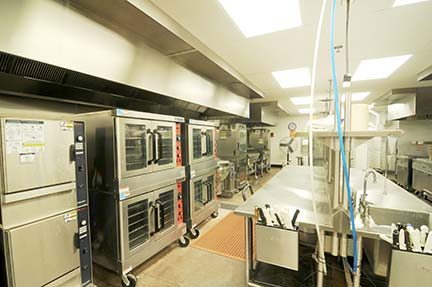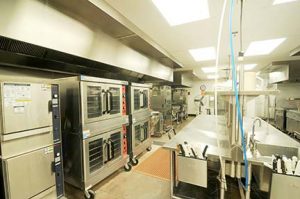
As with any kitchen, the oven is the heart of a commercial-grade operation. Because it’s such a big investment — in terms of ministry and money — design experts recommend thinking “outside the box” about some advanced, cost-saving options.
One type of oven — the Rational cooking center — has earned a resounding endorsement from Building God’s Way Founder Dan Cook. “[A Rational] is a cost-efficient option that makes sense to the business heads of church boards,” he explains. “It doesn’t require a big ventilation hood, and it can cook anything. It can even deep fry.”
This system also requires fewer staff and commercial kitchen training to operate. “It’s great for situations where a church wants to feed a lot of people the same meal,” Cook points out.
For their part, the experts at Quincy, IL-based Comstock-Castle Stove Co., warn churches against settling for a “commercial-type” or “commercial-style” residential range.
“There are many of these on the market now, and the price is far higher than real commercial ranges,” the company’s website states. “A real commercial range has far more cooking capacity and more durability, due to heavier materials used.”
While commercial-type residential ranges use slightly heavier materials and have more cooking power than their truly residential counterparts, they still have far less cooking power than a commercial range, according to the site. “At a very high price, they satisfy a demand for a little more cooking capacity, as well as giving the appliance a ‘commercial’ look.”
This is just one of several great articles from our Commercial-Grade Church Kitchens digital supplement — now available for download!
Comstock-Castle professionals contend that very few restaurants use commercial-type ranges in their operations because they need the “durability, productivity and price of the real thing.”
In the end, the cost of a commercial-type residential range compared to that of a real commercial range isn’t justifiable, they assert. “The savings can easily pay for proper commercial installation, with savings to spare, as well as getting the cooking performance and durability of a real commercial range.”
Outside-the-box oven options
On a smaller oven/range scale, Marcus White, director of hospitality at Florida’s First Baptist Church of Orlando and executive director of Global Association of Christian Hospitality Professionals (GACHP), also suggests an oven that doesn’t require a fire suppression system. “That small toasting oven you see at Subway is a $7,000 unit,” he says. “It toasts a sandwich in 15 seconds, but it doesn’t require a vent hood.”
For his part, Cookshack President and CEO Stuart Powell — a former pastor — says a smoker is a nice addition to a commercial kitchen. “Using it, a church can cook large pieces of meat to feed a larger volume of people at one time,” he says. “Also, they can do it using a cheaper cut of meat.”

His company’s SmartSmoker electric smoker line is designed to be simple to operate, easy to clean, and have a small footprint, all of which lend well to church kitchen use, he points out. One unit he recommends considering is the Model 260, which accommodates up to 550 pounds of chicken, fish, pork, vegetables and beef.
For outreach purposes, Powell uses another smoker in the line — the FEC500 — to cook and serve food for Friendship Feast, a Ponca City, OK-based mission, once a month. It smokes up to 500 pounds of pork, 450 pounds of brisket, 150 pounds of ribs, or 70 chickens per load.
As for what constitutes “commercial” oven use for an inspector, Eric MacInerney, principal and project architect at Hemisath Architects in Austin, TX, says the International Building Code, or IBC, has some grey area.
“For example, I’ve had to put a type-1 commercial hood over a residential range in a tiny kitchen because the inspector felt that the church was a commercial building (which it is) and thus, the kitchen was commercial (which is debatable),” he explains. “The building officials correctly see this as a life safety issue, so there’s very little you can do to argue; it’s best to just quickly find out where they stand and move forward based on that.”
MacInerney also points out that just because a church has a commercial kitchen, that doesn’t stipulate it must have a commercial stove — “just commercial venting,” he says.


